ESP JEEP PATRIOT 2016 1.G Owner's Manual
[x] Cancel search | Manufacturer: JEEP, Model Year: 2016, Model line: PATRIOT, Model: JEEP PATRIOT 2016 1.GPages: 148, PDF Size: 8.25 MB
Page 93 of 148
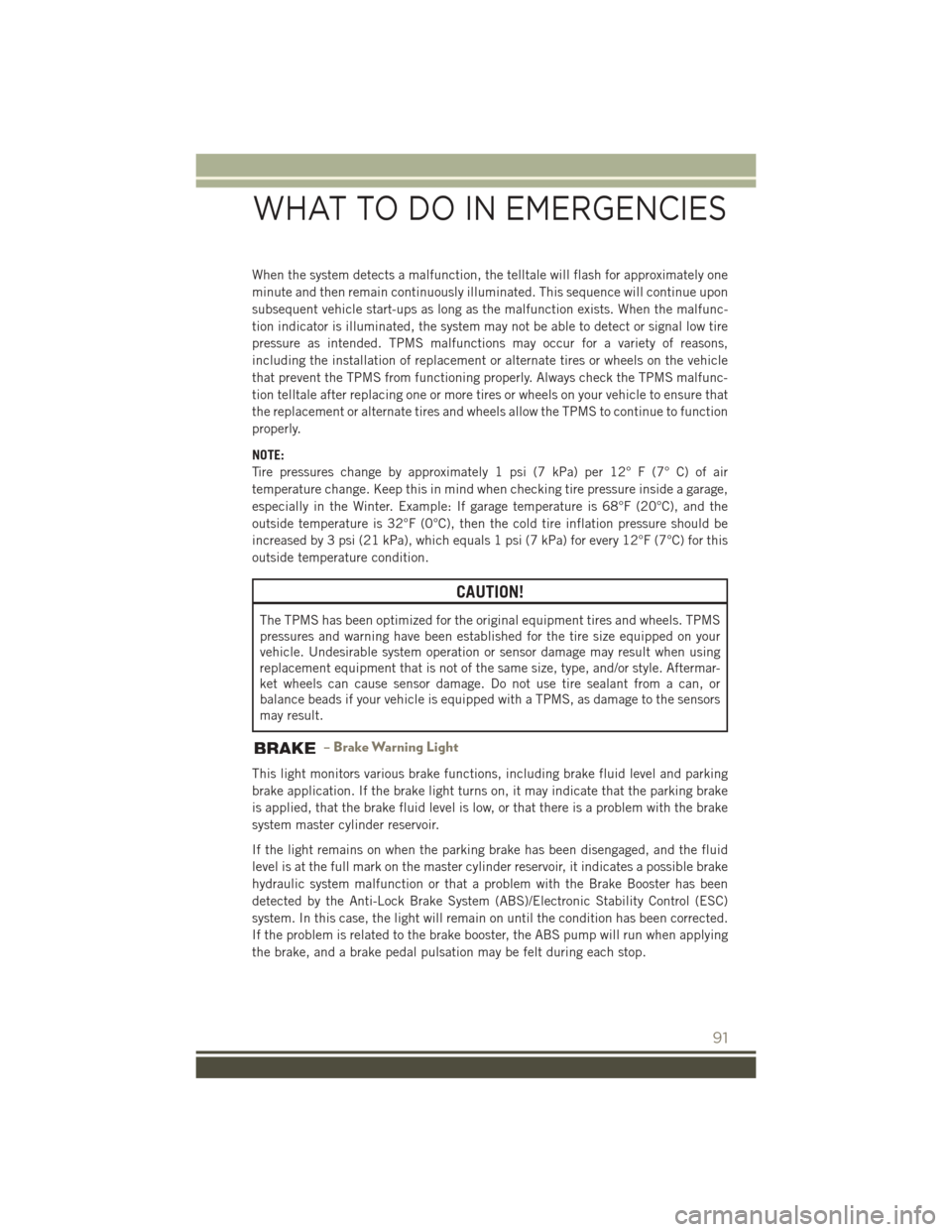
When the system detects a malfunction, the telltale will flash for approximately one
minute and then remain continuously illuminated. This sequence will continue upon
subsequent vehicle start-ups as long as the malfunction exists. When the malfunc-
tion indicator is illuminated, the system may not be able to detect or signal low tire
pressure as intended. TPMS malfunctions may occur for a variety of reasons,
including the installation of replacement or alternate tires or wheels on the vehicle
that prevent the TPMS from functioning properly. Always check the TPMS malfunc-
tion telltale after replacing one or more tires or wheels on your vehicle to ensure that
the replacement or alternate tires and wheels allow the TPMS to continue to function
properly.
NOTE:
Tire pressures change by approximately 1 psi (7 kPa) per 12° F (7° C) of air
temperature change. Keep this in mind when checking tire pressure inside a garage,
especially in the Winter. Example: If garage temperature is 68°F (20°C), and the
outside temperature is 32°F (0°C), then the cold tire inflation pressure should be
increased by 3 psi (21 kPa), which equals 1 psi (7 kPa) for every 12°F (7°C) for this
outside temperature condition.
CAUTION!
The TPMS has been optimized for the original equipment tires and wheels. TPMS
pressures and warning have been established for the tire size equipped on your
vehicle. Undesirable system operation or sensor damage may result when using
replacement equipment that is not of the same size, type, and/or style. Aftermar-
ket wheels can cause sensor damage. Do not use tire sealant from a can, or
balance beads if your vehicle is equipped with a TPMS, as damage to the sensors
may result.
– Brake Warning Light
This light monitors various brake functions, including brake fluid level and parking
brake application. If the brake light turns on, it may indicate that the parking brake
is applied, that the brake fluid level is low, or that there is a problem with the brake
system master cylinder reservoir.
If the light remains on when the parking brake has been disengaged, and the fluid
level is at the full mark on the master cylinder reservoir, it indicates a possible brake
hydraulic system malfunction or that a problem with the Brake Booster has been
detected by the Anti-Lock Brake System (ABS)/Electronic Stability Control (ESC)
system. In this case, the light will remain on until the condition has been corrected.
If the problem is related to the brake booster, the ABS pump will run when applying
the brake, and a brake pedal pulsation may be felt during each stop.
WHAT TO DO IN EMERGENCIES
91
Page 111 of 148
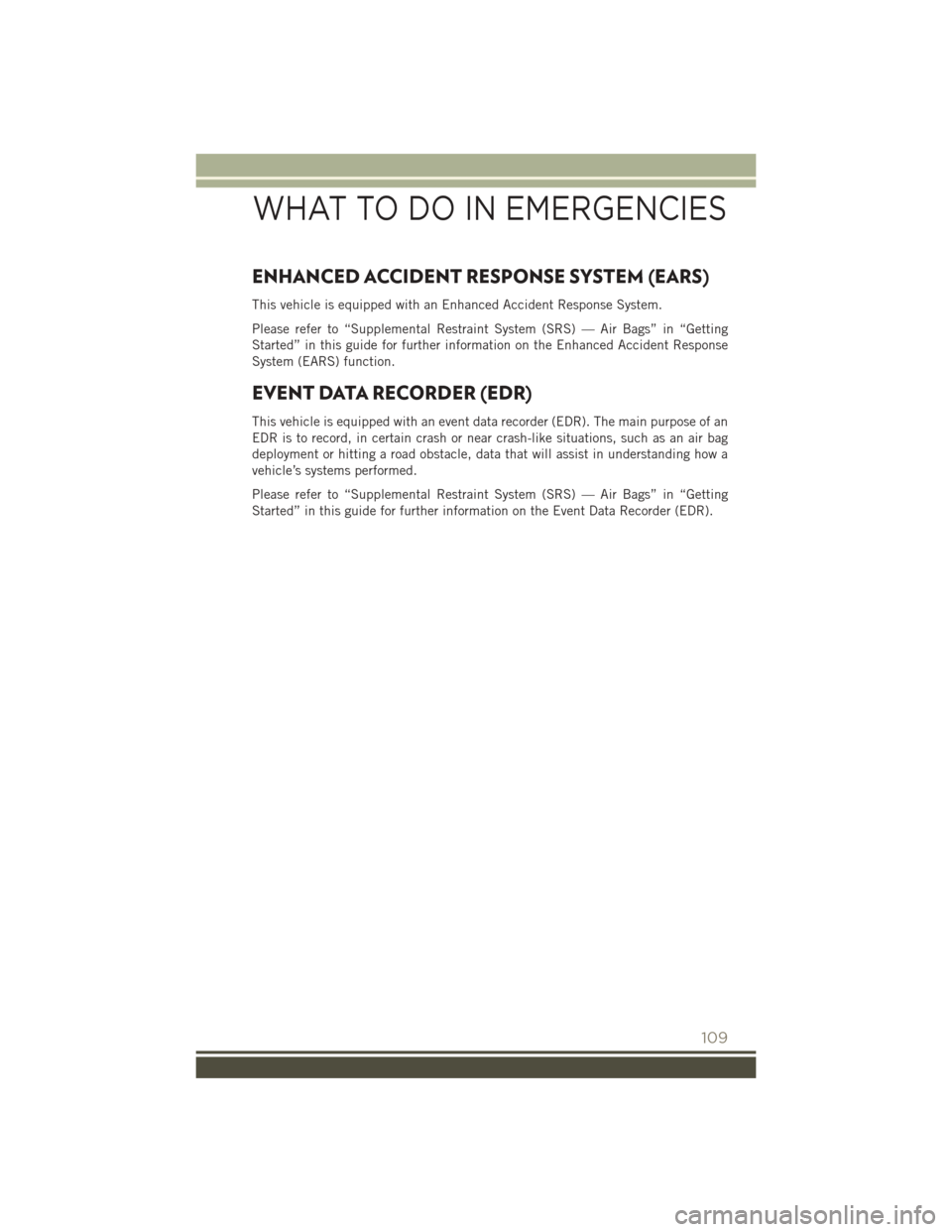
ENHANCED ACCIDENT RESPONSE SYSTEM (EARS)
This vehicle is equipped with an Enhanced Accident Response System.
Please refer to “Supplemental Restraint System (SRS) — Air Bags” in “Getting
Started” in this guide for further information on the Enhanced Accident Response
System (EARS) function.
EVENT DATA RECORDER (EDR)
This vehicle is equipped with an event data recorder (EDR). The main purpose of an
EDR is to record, in certain crash or near crash-like situations, such as an air bag
deployment or hitting a road obstacle, data that will assist in understanding how a
vehicle’s systems performed.
Please refer to “Supplemental Restraint System (SRS) — Air Bags” in “Getting
Started” in this guide for further information on the Event Data Recorder (EDR).
WHAT TO DO IN EMERGENCIES
109
Page 129 of 148
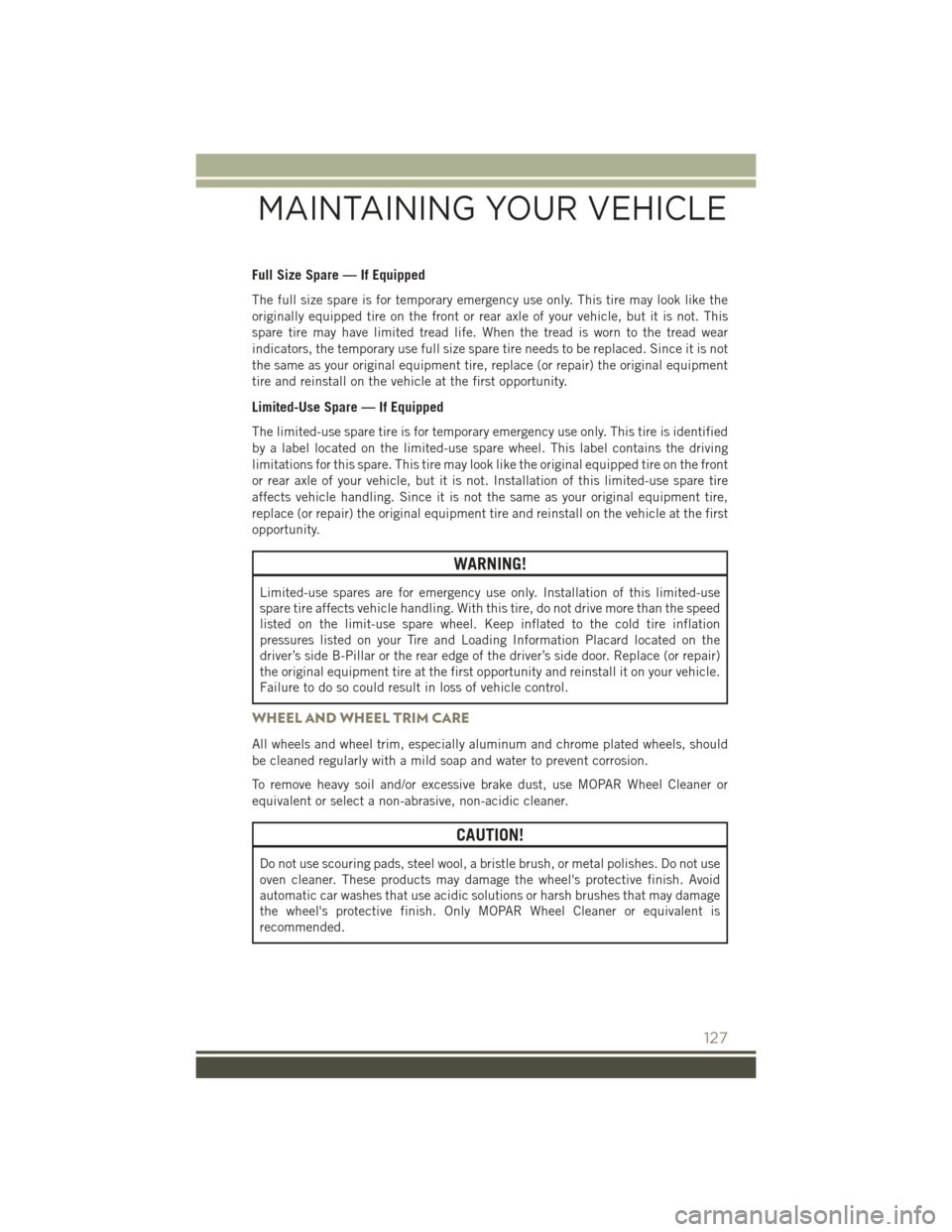
Full Size Spare — If Equipped
The full size spare is for temporary emergency use only. This tire may look like the
originally equipped tire on the front or rear axle of your vehicle, but it is not. This
spare tire may have limited tread life. When the tread is worn to the tread wear
indicators, the temporary use full size spare tire needs to be replaced. Since it is not
the same as your original equipment tire, replace (or repair) the original equipment
tire and reinstall on the vehicle at the first opportunity.
Limited-Use Spare — If Equipped
The limited-use spare tire is for temporary emergency use only. This tire is identified
by a label located on the limited-use spare wheel. This label contains the driving
limitations for this spare. This tire may look like the original equipped tire on the front
or rear axle of your vehicle, but it is not. Installation of this limited-use spare tire
affects vehicle handling. Since it is not the same as your original equipment tire,
replace (or repair) the original equipment tire and reinstall on the vehicle at the first
opportunity.
WARNING!
Limited-use spares are for emergency use only. Installation of this limited-use
spare tire affects vehicle handling. With this tire, do not drive more than the speed
listed on the limit-use spare wheel. Keep inflated to the cold tire inflation
pressures listed on your Tire and Loading Information Placard located on the
driver’s side B-Pillar or the rear edge of the driver’s side door. Replace (or repair)
the original equipment tire at the first opportunity and reinstall it on your vehicle.
Failure to do so could result in loss of vehicle control.
WHEEL AND WHEEL TRIM CARE
All wheels and wheel trim, especially aluminum and chrome plated wheels, should
be cleaned regularly with a mild soap and water to prevent corrosion.
To remove heavy soil and/or excessive brake dust, use MOPAR Wheel Cleaner or
equivalent or select a non-abrasive, non-acidic cleaner.
CAUTION!
Do not use scouring pads, steel wool, a bristle brush, or metal polishes. Do not use
oven cleaner. These products may damage the wheel's protective finish. Avoid
automatic car washes that use acidic solutions or harsh brushes that may damage
the wheel's protective finish. Only MOPAR Wheel Cleaner or equivalent is
recommended.
MAINTAINING YOUR VEHICLE
127
Page 136 of 148
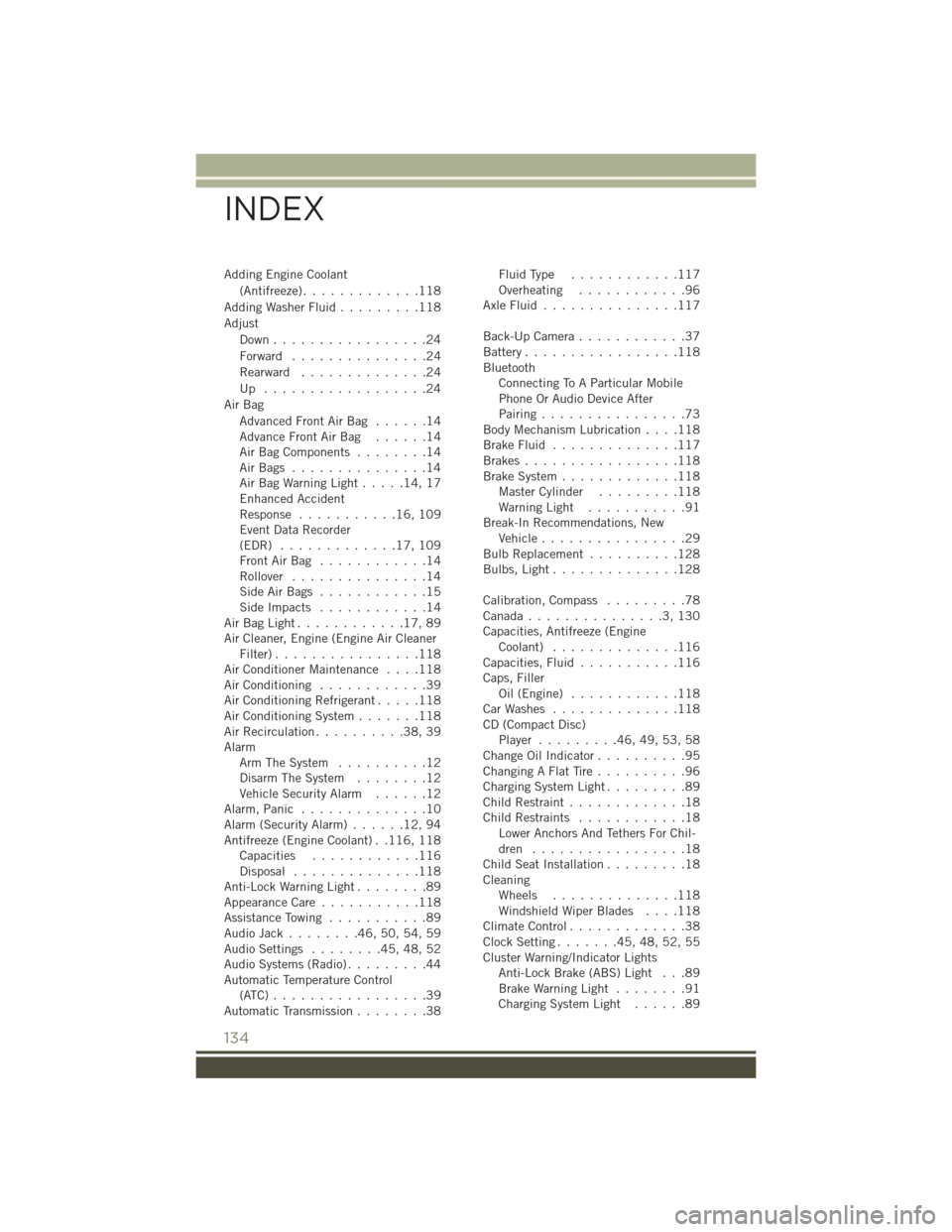
Adding Engine Coolant(Antifreeze) .............118
Adding Washer Fluid .........118
Adjust Down .................24
Forward ...............24
Rearward ..............24
Up ..................24
Air Bag AdvancedFrontAirBag ......14
AdvanceFrontAirBag ......14
AirBagComponents ........14
AirBags ...............14
AirBagWarningLight.....14,17
Enhanced Accident
Response ...........16,109
Event Data Recorder
(EDR) .............17,109
FrontAirBag ............14
Rollover ...............14
SideAirBags ............15
SideImpacts ............14
AirBagLight............17,89
Air Cleaner, Engine (Engine Air Cleaner Filter) ................118
Air Conditioner Maintenance ....118
Air Conditioning ............39
Air Conditioning Refrigerant .....118
Air Conditioning System .......118
Air Recirculation ..........38,39
Alarm Arm The System ..........12
Disarm The System ........12
Vehicle Security Alarm ......12
Alarm, Panic ..............10
Alarm (Security Alarm) ......12,94
Antifreeze (Engine Coolant) . .116, 118 Capacities ............116
Disposal ..............118
Anti-Lock Warning Light ........89
Appearance Care ...........118
Assistance Towing ...........89
Audio Jack ........46,50,54,59
Audio Settings ........45,48,52
Audio Systems (Radio) .........44
Automatic Temperature Control (ATC).................39
Automatic Transmission ........38 FluidType ............117
Overheating
............96
AxleFluid...............117
Back-Up Camera ............37
Battery .................118
Bluetooth Connecting To A Particular Mobile
Phone Or Audio Device After
Pairing ................73
Body Mechanism Lubrication ....118
BrakeFluid ..............117
Brakes.................118
Brake System .............118
Master Cylinder .........118
Warning Light ...........91
Break-In Recommendations, New Vehicle ................29
Bulb Replacement ..........128
Bulbs,Light..............128
Calibration, Compass .........78
Canada...............3,130
Capacities, Antifreeze (Engine Coolant) ..............116
Capacities, Fluid ...........116
Caps, Filler Oil (Engine) ............118
CarWashes ..............118
CD (Compact Disc) Player .........46,49,53,58
Change Oil Indicator ..........95
ChangingAFlatTire..........96
Charging System Light .........
89
Child Restraint .............18
Child Restraints ............18
Lower Anchors And Tethers For Chil-
dren .................18
Child Seat Installation .........18
Cleaning Wheels ..............118
Windshield Wiper Blades ....118
Climate Control .............38
Clock Setting .......45,48,52,55
Cluster Warning/Indicator Lights Anti-Lock Brake (ABS) Light . . .89
Brake Warning Light ........91
Charging System Light ......89
INDEX
134
Page 137 of 148
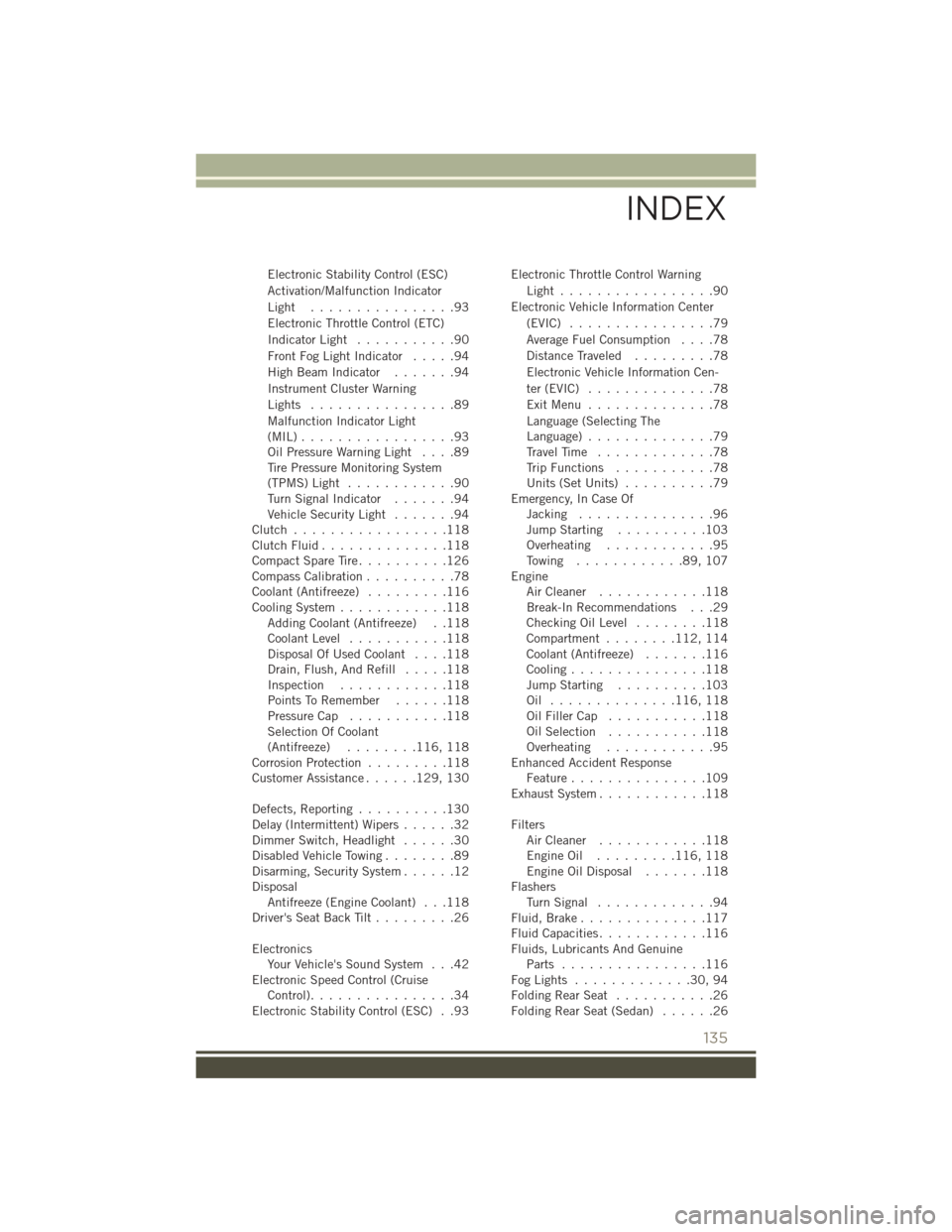
Electronic Stability Control (ESC)
Activation/Malfunction Indicator
Light ................93
Electronic Throttle Control (ETC)
Indicator Light...........90
FrontFogLightIndicator .....94
HighBeamIndicator .......94
Instrument Cluster Warning
Lights ................89
Malfunction Indicator Light
(MIL).................93
Oil Pressure Warning Light ....89
Tire Pressure Monitoring System
(TPMS) Light ............90
Turn Signal Indicator .......94
Vehicle Security Light .......94
Clutch .................118
ClutchFluid..............118
Compact Spare Tire ..........126
Compass Calibration ..........78
Coolant (Antifreeze) .........116
Cooling System ............118
Adding Coolant (Antifreeze) . .118
Coolant Level ...........118
Disposal Of Used Coolant ....118
Drain, Flush, And Refill .....118
Inspection ............118
Points To Remember ......118
Pressure Cap ...........118
Selection Of Coolant
(Antifreeze) ........116, 118
Corrosion Protection .........118
Customer Assistance ......129, 130
Defects, Reporting ..........130
Delay (Intermittent) Wipers ......32
Dimmer Switch, Headlight ......30
Disabled Vehicle Towing ........89
Disarming, Security System ......12
Disposal Antifreeze (Engine Coolant) . . .118
Driver's Seat Back Tilt .........26
Electronics Your Vehicle's Sound System . . .42
Electronic Speed Control (Cruise Control) ................34
Electronic Stability Control (ESC) . .93 Electronic Throttle Control Warning
Light.................90
Electronic Vehicle Information Center (EVIC) ................79
Average Fuel Consumption ....78
Distance Traveled .........78
Electronic Vehicle Information Cen-
ter(EVIC) ..............78
ExitMenu ..............78
Language (Selecting The
Language) ..............79
Travel Time .............78
Trip Functions ...........78
Units (Set Units) ..........79
Emergency, In Case Of Jacking ...............96
Jump Starting ..........103
Overheating ............95
Towing ............89,107
Engine Air Cleaner ............118
Break-In Recommendations . . .29
Checking Oil Level ........118
Compartment ........112, 114
Coolant (Antifreeze) .......116
Cooling ...............118
Jump Starting ..........103
Oil .............. 116, 118
Oil Filler Cap ...........118
Oil
Selection ...........118
Overheating ............95
Enhanced Accident Response Feature ...............109
Exhaust System ............118
Filters Air Cleaner ............118
EngineOil ......... 116, 118
Engine Oil Disposal .......118
Flashers TurnSignal .............94
Fluid, Brake ..............117
Fluid Capacities ............116
Fluids, Lubricants And Genuine Parts ................116
FogLights .............30,94
FoldingRearSeat ...........26
FoldingRearSeat(Sedan) ......26
INDEX
135
Page 147 of 148
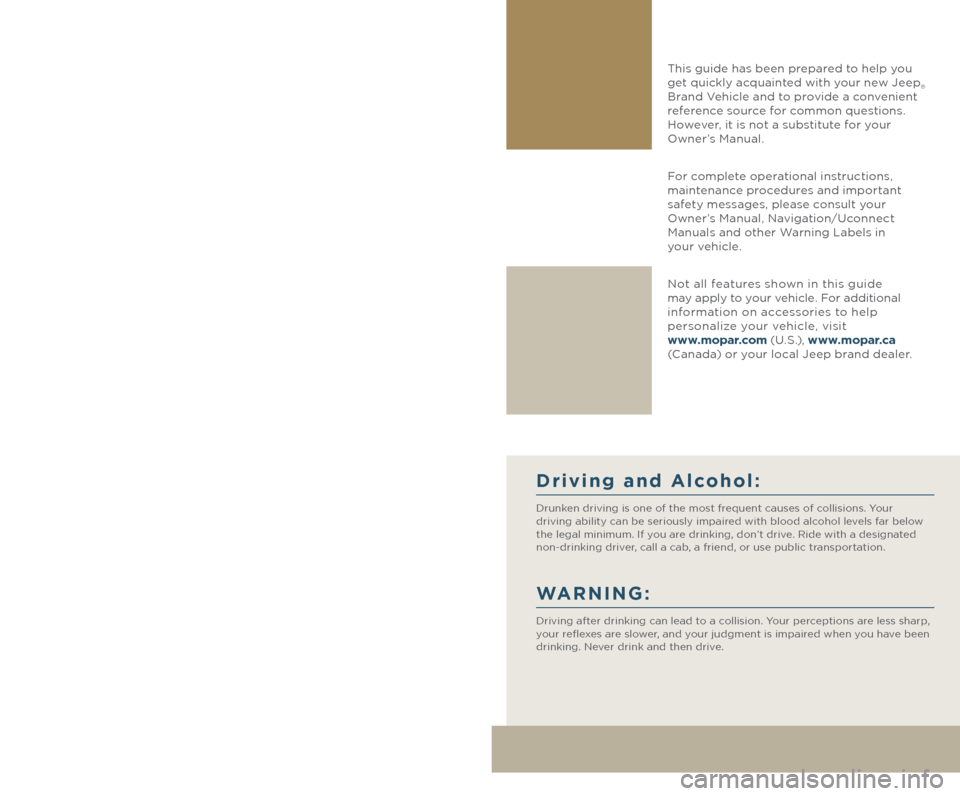
The driver’s primary
responsibility is the
safe operation of the
vehicle. Driving while
distracted can result in
loss of vehicle control,
resulting in a collision
and personal injury.
FCA US LLC strongly
recommends that the
driver use extreme
caution when using any
device or feature that
may take their attention off the road. Use of any
electrical devices, such
as cellular telephones,
computers, portable
radios, vehicle navigation
or other devices, by the
driver while the vehicle is
moving is dangerous
and could lead to a
serious collision. Texting
while driving is also
dangerous and should
never be done while the
vehicle is moving. If you find yourself unable to
devote your full attention
to vehicle operation, pull
off the road to a safe
location and stop your
vehicle. Some states
or provinces prohibit
the use of cellular
telephones or texting
while driving. It is always
the driver’s responsibility
to comply with all
local laws.
Driving and Alcohol:
Drunken driving is one of the most frequent causes of collisions. Your
driving ability can be seriously impaired with blood alcohol levels far below
the legal minimum. If you are drinking, don’t drive. Ride with a designated
non-drinking driver, call a cab, a friend, or use public transportation.
WARNING:
Driving after drinking can lead to a collision. Your perceptions are less sharp,
your reflexes are slower, and your judgment is impaired when you have been
drinking. Never drink and then drive.
If you are the first registered retail owner of your vehicle,
you may obtain a complimentary printed copy of the Owner’s
Manual, Navigation/Uconnect Manuals or Warranty Booklet
by calling 1-877-426-5337 (U.S.) or 1-800-387-1143 (Canada)
or by contacting your dealer.
Important:
This User Guide is intended to familiarize you with the important features of
your vehicle. The DVD enclosed contains your Owner’s Manual, Navigation/
Uconnect Manuals, Warranty Booklets, Tire Warranty and Roadside Assistance
(new vehicles purchased in the U.S.) or Roadside Assistance (new vehicles
purchased in Canada) in electronic format. We hope you find it useful.
Replacement DVD kits may be purchased by visiting www.techauthority.com.
This guide has been prepared to help you
get quickly acquainted with your new Jeep
®
Brand Vehicle and to provide a convenient
reference source for common questions.
However, it is not a substitute for your
Owner’s Manual.
For complete operational instructions,
maintenance procedures and important
safety messages, please consult your
Owner’s Manual, Navigation/Uconnect
Manuals and other Warning Labels in
your vehicle.
Not all features shown in this guide
may apply to your vehicle. For additional
information on accessories to help
personalize your vehicle, visit
www.mopar.com (U. S .), www.mopar.ca
(Canada) or your local Jeep brand dealer.
2126530_16b_Patriot_UG_REV1_080415.indd 28/4/15 2:37 PM